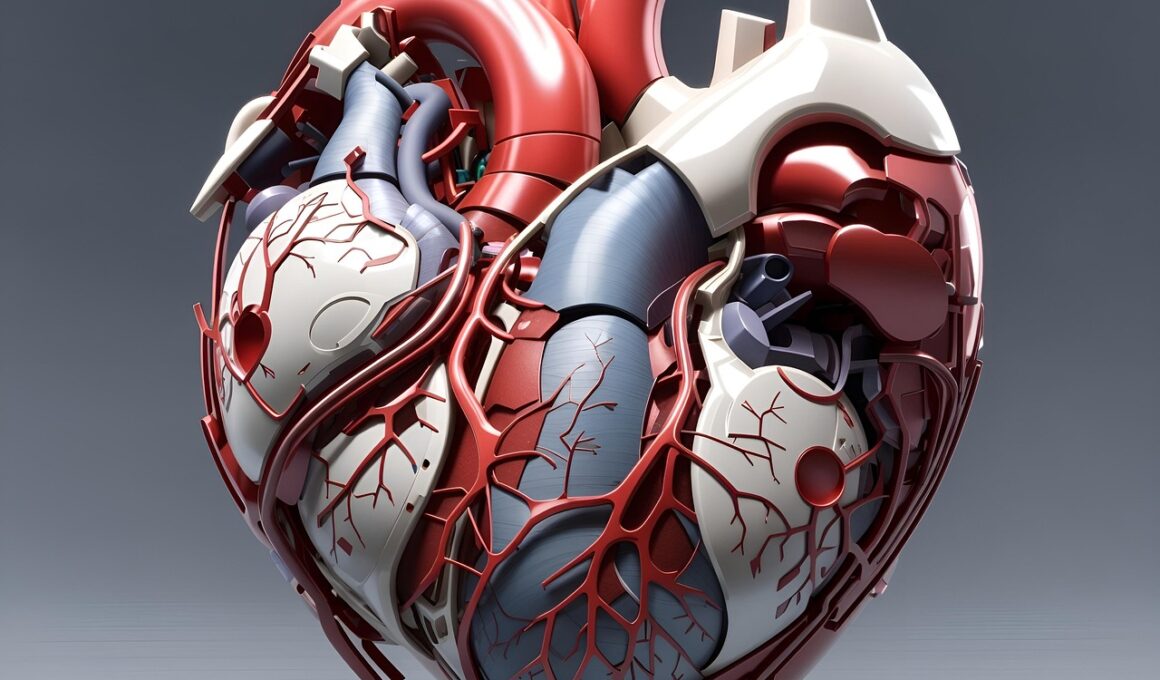Role of Exercise in Preventing Cardiovascular Disease Progression
Cardiovascular disease (CVD) remains a leading cause of mortality worldwide. It encompasses various disorders affecting the heart and blood vessels. Engaging in regular exercise is crucial for preventing the onset and progression of these diseases. Physical activity enhances overall cardiovascular health by improving heart function, enhancing blood flow, and reducing lipid levels within the bloodstream. Through structured exercise programs, individuals can significantly decrease their risk of heart attacks and strokes. Moreover, exercise acts as a natural stress reliever, decreasing the likelihood of anxiety and depression which are often linked with cardiovascular issues. Aerobic exercises such as jogging, swimming, or cycling can greatly build stamina, thereby contributing to better heart health. In addition, strength training aids in muscle development, which complements aerobic fitness seamlessly. Healthcare professionals often recommend creating a personalized exercise plan tailored to individual capabilities. This approach fosters long-term adherence and optimal results. In summary, exercise provides multiple benefits, including improved mental health and physical fitness, all leading to enhanced cardiovascular well-being and a lower risk of disease progression. Regular check-ups with a healthcare provider can assist in fine-tuning such exercise plans.
Understanding the mechanics of cardiovascular health unveils the deeper connection between exercise and heart function. It is essential to recognize that different forms of exercise influence cardiovascular health diversely. For instance, aerobic exercises are instrumental in raising heart rate and oxygen consumption. Such activities encourage the heart muscles to strengthen over time. Furthermore, consistent aerobic training leads to improved lung capacity and efficiency. On the other hand, resistance training can contribute to lower blood pressure and improved lipid profiles. Both forms of exercise yield significant adaptations in the cardiovascular system. These adaptations include arterial elasticity enhancement, reducing arterial stiffness associated with aging and unhealthy lifestyles. Regular physical activity also promotes optimal body weight management, minimizing obesity—the primary risk factor for CVD. Evidence suggests that metabolic health significantly improves with regular movement, as individuals can manage blood sugar levels and insulin sensitivity more effectively. Specific populations, such as those recovering from heart surgeries or heart attacks, particularly benefit from supervised exercise regimens, ensuring safety and effectiveness. This multifaceted approach to exercise tagging its importance could vastly reduce the societal burden of cardiovascular diseases.
Exercise Guidelines for Heart Health
Establishing exercise guidelines is pivotal for individuals focused on heart health. The general consensus recommends engaging in at least 150 minutes of moderate-intensity aerobic exercise weekly. Activities can be broken down into manageable segments, making consistency easier. In addition to aerobic exercise, incorporating strength training exercises at least two times per week is beneficial. These sessions can include exercises targeting major muscle groups, enhancing muscle tone and overall endurance levels. Once individuals have established a fitness foundation, varying exercise routines can prevent boredom and encourage long-term adherence. Also, incorporating flexibility and balance exercises, such as yoga or tai chi, can improve overall fitness levels and reduce the risk of injuries. Before starting a new exercise program, especially for those with existing health concerns, consulting healthcare professionals is advisable. They can provide tailored recommendations based on individual health status. This guidance is crucial for individuals who may need to ease into exercise safely. Emphasizing enjoyment and diversity in physical activities further encourages sustained participation. Ultimately, the recommended guidelines serve to establish a clear pathway towards better cardiovascular health and the prevention of disease.
Incorporating lifestyle changes alongside exercise enhances the cardiovascular benefits further. A heart-healthy diet rich in fruits, vegetables, whole grains, lean proteins, and healthy fats plays a supportive role in overall health. Nutrition impacts cardiovascular health as significantly as physical activity. Monitoring sodium intake is crucial for those with hypertension, promoting stable blood pressure levels. Avoiding processed foods high in sugars and unhealthy fats can also assist in achieving healthy cholesterol levels. Consistency in both diet and exercise can lead to profound improvements in health outcomes for those at risk of cardiovascular diseases. Additionally, smoking cessation, limiting alcohol intake, and managing stress are key lifestyle modifications that provide substantial benefits. Individuals must stay hydrated by consuming adequate water throughout the day, especially if engaging in intense workouts. Education on recognizing signs of cardiovascular distress, such as chest pain or shortness of breath, is equally important. Regularly monitoring one’s physical responses during exercises fosters safer practices in physical routines. Moreover, making gradual adjustments to exercise intensity ensures the cardiovascular system adapts efficiently, minimizing injury risks and maximizing health gains.
The Psychological Benefits of Regular Exercise
Engaging in regular physical activity proves beneficial not only for physical health but also for mental well-being. Exercise has been shown to alleviate symptoms of anxiety, stress, and depression, conditions often intertwined with heart disease. Regular participation in exercise stimulates the release of endorphins, neurotransmitters that promote feelings of happiness and euphoria. Consequently, this natural “feel-good” effect can influence overall quality of life. Community-based exercise programs foster social interactions, creating a support system that can motivate individuals to adhere to their fitness regimes. This supportive environment enhances emotional resilience while actively reducing feelings of isolation and loneliness, common in those battling health concerns. Participating in group exercises or team sports adds another layer of motivation, providing accountability, while establishing concrete social networks. Marketed campaigns promoting physical activity stress unity and encouragement, targeting individuals who may feel intimidated by structured exercise. Furthermore, mindfulness practices, integrated within exercise routines, amplify mental clarity and breathing control. Combining these benefits creates an overall positive feedback loop, whereby enhanced mental health aids commitment to physical activity, ultimately leading to lower cardiovascular disease risks.
Ongoing research continues to explore the intricate relationship between exercise and cardiovascular disease prevention. Recent studies reveal specific mechanisms through which physical activity mitigates heart disease progression. For instance, exercise-induced angiogenesis, the formation of new blood vessels, enhances oxygen and nutrient delivery throughout the body. This adaptation significantly benefits individuals with existing cardiovascular risks, improving heart muscle function. Enhanced arterial flexibility observed in active individuals also supports efficient blood flow, consequently lowering blood pressure levels overall. The role of inflammation in heart disease progression has garnered attention, emphasizing the need for physical activity as a natural anti-inflammatory agent. Exercise aids in regulating inflammatory markers, easing chronic inflammation linked to various heart diseases. Lastly, ongoing studies assess the optimal duration, frequency, and types of exercises needed for maximum heart health benefits. This research lays the groundwork for future exercise recommendations tailored to specific populations at risk. Understanding the nuances within this field helps sharpen preventive strategies, with exercise standing out as a cornerstone of effective cardiovascular disease management. Increased awareness and education can enhance public health campaigns targeting exercise promotion.
Final Thoughts on Exercise and Heart Health
In conclusion, exercise significantly impacts cardiovascular disease prevention and progression management. Individuals must seize opportunities to incorporate physical activity into their daily lives. The overall quality of life improves with consistent engagement in exercise routines, with far-reaching benefits extending to mental health as well. Furthermore, establishing supportive environments encourages adherence to exercise practices among diverse populations. Tailoring fitness plans based on individual capabilities, along with dietary considerations, optimizes heart health outcomes. As communities continue to prioritize physical activity, increased levels of health awareness persist—empowering individuals to take charge of their cardiovascular wellness. Ultimately, adopting a holistic approach by intertwining exercise with other lifestyle modifications optimally prepares individuals against the growing tide of cardiovascular diseases. The collective effort of society—from healthcare providers to community programs—can herald a significant shift towards a healthier future. Fostering an active lifestyle must be at the forefront of preventive healthcare initiatives. A healthier population ultimately results in lower healthcare costs, improved mental health, and enhanced productivity. Exercise is a powerful tool, a fundamental piece in the strategy against cardiovascular disease.


